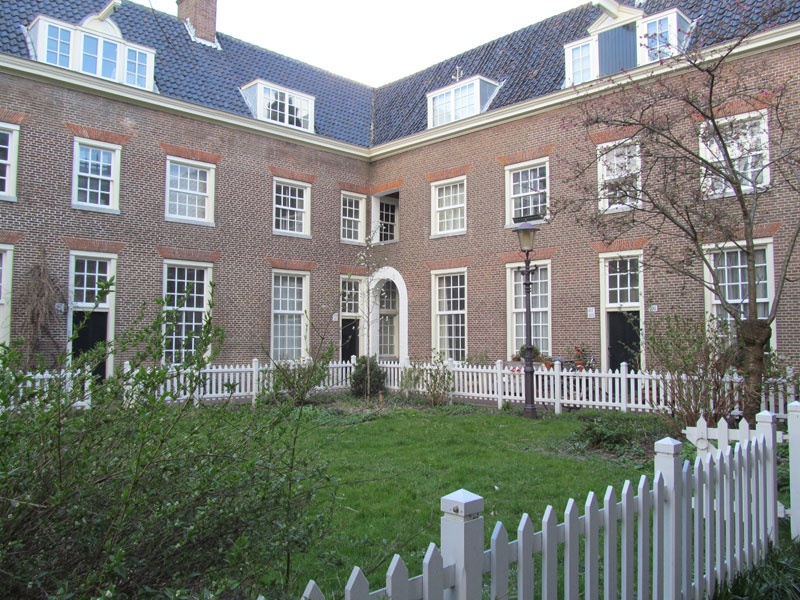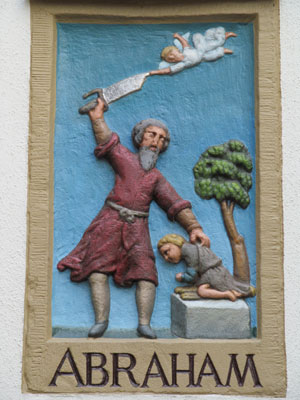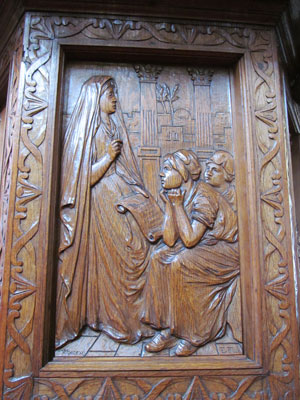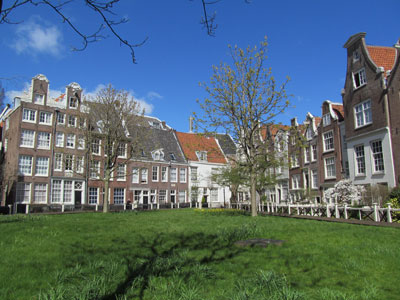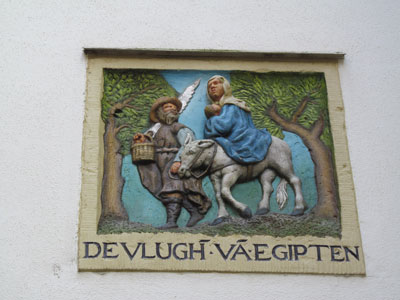Hidden hofjes of Amsterdam
This item appears on page 61 of the August 2013 issue.
(Part 1 of 2 on the Netherlands)
Let me tell you how it is I came to be in Amsterdam and why I decided to visit some of the special “hidden” places that are called hofjes.
On April 30, 2013, the Dutch Queen Beatrix abdicated, after 33 years on the throne, and her eldest son became King Willem-Alexander, the first Dutch male monarch in 123 years. I wanted to be there for the festivities. Besides, I knew the tulips would be in bloom at the end of April.
But royal events bring crowds, and as the big day approached, the streets of Amsterdam started to fill. I wanted to find quiet corners of the city free of merrymakers — at least, once in a while. The hofjes were the perfect solution.
“Hofje” is the Dutch word for a courtyard. In the Middle Ages, there were many hofjes in the Netherlands surrounded by almshouses and usually inhabited by Roman Catholic women who did not take vows as nuns but wanted nevertheless to live together in a religious-oriented community.
Later on, after the Protestant Reformation in the 16th century, not only did the majority of these hofjes become Protestant but their nature changed. Wealthy benefactors began to fund the building and maintenance of hofjes, considering it both a religious and a charitable deed — an “admission card” to heaven, as one hofje resident informed me.
Hofjes were built with a garden and a water pump. The surrounding houses were almost always two or three stories tall. There was usually just one entry from the street, often leading down a long, narrow corridor into the courtyard, itself.
The inhabitants of the hofje were usually, although not always, elderly, impoverished women who received free shelter in addition to an allotment of turf for heating plus food and a modest sum of spending money.
It was these hofjes that offered me serenity in the midst of a busy city.
Hofjes left in Amsterdam
It is estimated that there are 30 hofjes remaining in Amsterdam’s inner city, with many located in an area called Jordaan, about a 20-minute walk west of the Centraal rail station. I visited six hofjes in Jordaan or nearby and took a quick look at three more besides. There was also a tenth hofje I visited, the most famous one in Amsterdam.
With a good city map, it’s easy to plan a walk to include all the hofjes I visited.
I began with Zon’s Hofje, located at Nos. 159 to 171 on Prinsengracht, not actually in Jordaan but just across the canal from it. Approached by a long, dark corridor, this is a small hofje where a Mennonite church once stood. When this church merged with another Mennonite congregation, it was decided to close the church, leaving an almshouse for elderly Mennonite women.
The merging of the two congregations is commemorated by the 1765 clock inside the courtyard. There’s a carving beneath the clock of a sun (Zon) and a Noah’s Ark, the name given to the other Mennonite congregation.
Steps away at Nos. 85 to 133 Prinsengracht behind an impressive entrance is Van Brienen Hofje. It was founded in 1804 by Arnout Jan van Brienen for elderly Catholics. Here, again, a long corridor leads to a courtyard with neatly trimmed box hedges, magnolia trees, wrought-iron tables and chairs and a water pump topped by an iron lantern.
Crossing over the Prinsengracht into Jordaan, you’ll find two hofjes to take a brief look at on Lindengracht. The Lindenhofje, at Nos. 94 to 112, cannot be visited because it is now a children’s hospice, but there is a picture beside the main door to show you what its courtyard looks like.
Farther along Lindengracht at Nos. 149 to 163 is the Suykerhofje, founded in 1667 by Pieter
Jansz. Suyker for Protestant women.
Once a medieval monastery
At Nos. 89 to 171 on Karthuizersstraat is the Karthuizerhofje, one of the largest hofjes in Amsterdam. It was built on the site of a 14th-century Carthusian monastery.
The earliest hofje on the site once had 100 houses. Sixty-five remain, surrounding a courtyard with two 17th-century water pumps. Above the inside entrance is a colorful plaque depicting a small sailing vessel with sails furled.
Concordiahofje, nearby at Nos. 351 to 381 Westerstraat, is relatively recent (1864) but is worth a quick look to see what a more “modern” hofje looks like.
More interesting, however, is Zevenkeurvorstenhofje at Nos. 199 to 225 Tuinstraat. Founded in 1645 by Cornelis Martensz. Pronck for indigent elderly Catholic women, it’s a long, narrow courtyard with what was once a chapel dominating one end. Its name translates as “Seven Electors” and may refer to the seven archbishops and nobles from among whom the Holy Roman Emperor was selected.
Close by at Nos. 1 to 5 Eerste Egelantiersdwarsstraat is the Claes Claeszhofje, one of my favorites. It was founded in 1616 by Claes Claesz. Anslo, a cloth merchant. This hofje is actually a series of three small courtyards joined together in an atmospheric hodgepodge. On the outside of this hofje, next to a second entrance at Nos. 18 to 50 Egelantiersstraat, is a plaque depicting a hand writing. The house with this plaque, Huis met de Schrijvende Hand (The House with the Writing Hand), is the oldest in this complex of buildings.
St. Andrieshofje at Nos. 107 to 145 Egelantiersgracht is as old as Claes Claesszhofje. It was founded in 1614 by Jeff Gerrits, a wealthy farmer, for elderly Catholic women. It has a unique entry corridor lined with lovely Delft tiles leading to a courtyard with an overgrown garden. Look for the plaque in the courtyard that says “Vrede sy met u” (“Peace be with you”).
Most famous hofje
Amsterdam’s most famous hofje, the Begijnhof, is not located in the Jordaan neighborhood but is found in the central part of Amsterdam at Gedempte Begijnensloot. It’s just a 10-minute walk from the Dam, the city’s main square, where the Royal Palace is located.
This is one of the city’s oldest hofjes. Although its date of founding is not certain (some speculate it may be as early as 1150), it is certain that it was in existence before the end of the 1300s as a place for Catholic women to live together without taking religious vows.
Here houses — no two exactly alike — surround a garden with two chapels. The first, the Engelse Kerk, built around 1400, was taken over by Calvinists in 1578 and was used by the Pilgrims in 1607 as their chapel before they began their journey across the Atlantic on the Mayflower (a stained-glass window at the front of the chapel commemorates the Pilgrims). There’s also a pulpit nearby with four panels designed by Piet Mondrian when he was a very young artist.
Across from this chapel is another built by Catholics a century after the Calvinist confiscation. It has beautiful stained-glass windows.
The most notable of the houses in the Begijnhof is Het Houten Huys, at No. 34. It’s not only one of the oldest houses in Amsterdam but is unusual because it’s one of the few wooden houses to have survived the fires of the past six centuries that periodically ravaged Amsterdam. The wall next door to the left is covered with plaques depicting biblical themes.
However, if it’s peace and quiet you’re after, you probably won’t find it at the Begijnhof, except perhaps if you sit inside one of the two chapels. Begijnhof is one of Amsterdam’s prime tourist attractions. It definitely should be visited, but for getting away from the hustle and bustle of the city, try the hofjes in or near Jordaan.
If you go…
Hours that the hofjes are open can be erratic (except for the Begijnhof, whose hours are regular: daily, 9 to 5) but generally are from 9 to 5 or 6 on weekdays and sometimes on Saturdays as well.
Remember that people still live in these hofjes, although not the elderly poor of centuries past, so respect their privacy when visiting these courtyards.
My husband, Paul, and I spent 22 nights in an atmospheric canal house apartment on the Singel, one of Amsterdam’s inner canals. Located five minutes from the Royal Palace, the apartment made us feel like royals, ourselves.
Our stylish, one-bedroom apartment had six huge living/dining room windows facing the canal, with amenities such as a gas fireplace, dishwasher, washer/dryer and cable TV.
The only difficulty, for some, might be the steep staircase leading up to the third-floor apartment, but I managed this several times a day, even with my recent knee replacement.
The high-season rate (March 15 to Oct. 31) is €1,425 (near $1,853) per week. The low-season rate is €100 less per week. There is also a 5.5% tourist tax.
We rented through Pied a Terre Properties (Prinsengracht 921-A, Amsterdam 1017KD, The Netherlands; phone 31 20 625 5195), which has six other Amsterdam canal house apartments.

